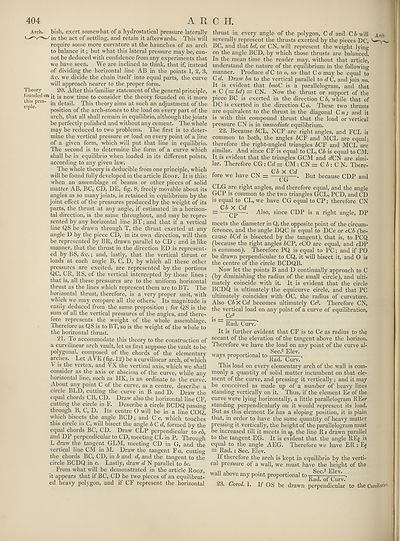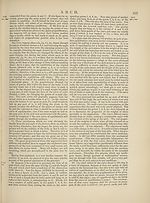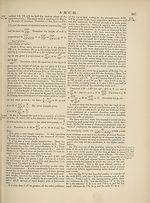Encyclopaedia Britannica > Volume 3, Anatomy-Astronomy
(412) Page 404
Download files
Complete book:
Individual page:
Thumbnail gallery: Grid view | List view

404
A R C H.
Arch, bish, exert somewhat of a hydrostatical pressure laterally
in the act of settling, and retain it afterwards. This will
require some more curvature at the haunches of an arch
to balance it; but what this lateral pressure may be, can¬
not be deduced with confidence from any experiments that
we have seen. We are inclined to think, that if, instead
of dividing the horizontal line AB in the points 1, 2, 3,
&c. we divide the chain itself into equal parts, the curve
will approach nearer to the proper form.
Theory 20. After this familiar statement of the general principle,
founded on is now time consider the theory founded on it more
ci !LPnn' This theory aims at such an adjustment of the
position of the arch-stones to the load on every part of the
arch, that all shall remain in equilibrio, although the joints
be perfectly polished and without any cement. The whole
may be reduced to two problems. The first is to deter¬
mine the vertical pressure or load on every point of a line
of a given form, which will put that line in equilibrio.
The second is to determine the form of a curve which
shall be in equilibrio when loaded in its different points,
according to any given law.
The whole theory is deducible from one principle, which
will be found fully developed in the article Roof. It is this:
when an assemblage of beams or other pieces of solid
matter AB, BC, CD, DE, fig. 8, freely movable about its
angles as so many joints, is retained in equilibrium by the
joint effect of the pressures produced by the weight of its
parts, the thrust at any angle, if estimated in a horizon¬
tal direction, is the same throughout, and may be repre¬
sented by any horizontal line BT; and that if a vertical
line QS be drawn through T, the thrust exerted at any
angle D by the piece CD, in its own direction, will then
be represented by BR, drawn parallel to CD ; and in like
mapner, that the thrust in the direction ED is represent¬
ed by BS, &c.; and, lastly, that the vertical thrust or
loads at each angle B, C, D, by which all these other
pressures are excited, are represented by the portions
QC, CR, RS, of the vertical intercepted by those lines ;
that is, all these pressures are to the uniform horizontal
thrust as the lines which represent them are to BT. The
horizontal thrust, therefore, is a very proper unit, with
which we may compare all the others. Its magnitude is
easily deduced from the same proposition ; for QS is the
sum of all the vertical pressures of the angles, and there¬
fore represents the weight of the whole assemblage.
Iherefore as QS is to BT, so is the weight of the whole to
the horizontal thrust.
21. To accommodate this theory to the construction of
a curvilinear arch vault, let us first suppose the vault to be
polygonal, composed of the chords of the elementary
arches. Let AVE (fig. 12) be a curvilinear arch, of which
V is the vertex, and VA the vertical axis, which we shall
consider as the axis or abscissa of the curve, while any
horizontal line, such as HK, is an ordinate to the curve.
About any point C of the curve, as a centre, describe a
circle BED, cutting the curve in B and D. Draw the
equal chords CB, CD. Draw also the horizontal line CF,
cutting the circle in F. Describe a circle BCDQ passing
through B, C, D. Its centre O will be in a line COCA
which bisects the angle BCD; and C c, which touches
this circle in C, will bisect the angle bCd, formed by the
equal chords BC, CD. Draw CLP perpendicular to cb,
and DP perpendicular to CD, meeting CL in P. Through
L draw the tangent GLM, meeting CD in G, and the
vertical line CM in M. Draw the tangent Fa, cuttino-
the chords BC, CD, in b and d, and the tangent to the
circle BCDQ in c. Lastly, draw d N parallel to be.
From what will be demonstrated in the article Roof,
it appears that if BC, CD be two pieces of an equilibrat¬
ed heavy polygon, and if CF represent the horizontal
thrust in every angle of the polygon, C d and C b will Arch
severally represent the thrusts exerted by the pieces DC, v—
BC, and that bd, or CN, will represent the weight lying
on the angle BCD, by which those thrusts are balanced.
In the mean time the reader may, without that article,
understand the nature of the equilibrium in the following
manner. Produce C to o, so that C o may be equal to
C d. Draw bn to the vertical parallel to d C, and join no.
It is evident that bnoG is a parallelogram, and that
w C (= bd) = CN. Now the thrust or support of the
piece BC is exerted in the direction C b, while that of
DC is exerted in the direction Co. These two thrusts
are equivalent to the thrust in the diagonal C re ; and it
is with this compound thrust that the load or vertical
pressure CN is in immediate equilibrium.
22. Because 6CL, NCF are right angles, and FCL is
common to both, the angles 6CF and MCL are equal;
therefore the right-angled triangles 6CF and MCL are
similar. And since CF is equal to CL, C6 is equal to CM.
It is evident that the triangles GCM and t?CN are simi¬
lar. Therefore CG: Ce? = CM : CN — C 6 : C N. There¬
fore we have CN = —Cc?. But because CDP and
Hjr
CLG are right angles, and therefore equal, and the angle
GCP is common to the two triangles GCL, PCD, and CD
is equal to CL, we have CG equal to CP; therefore CN
C6 x Cd
CP ■
Also, since CDP is a right angle, DP
meets the diameter in Q, the opposite point of the circum¬
ference, and the angle DQC is equal to DCc or cC6 (be¬
cause 6Cc? is bisected by the tangent), that is, to PCQ
(because the right angles iCP, cCO are equal, and cDP
is common). Therefore PQ is equal to PC; and if PO
be drawn perpendicular to CQ, it will bisect it, and O is
the centre of the circle BCDQB.
Now let the points B and D continually approach to C
(by diminishing the radius of the small circle), and ulti¬
mately coincide with it. It is evident that the circle
BCDQ is ultimately the equicurve circle, and that PC
ultimately coincides with OC, the radius of curvature.
Also Cb X Cd becomes ultimately Cc2. Therefore CN,
the vertical load on any point of a curve of equilibration,
Cc2
Rad. Curv. ’
It is further evident that CF is to Cc as radius to the
secant of the elevation of the tangent above the horizon.
Therefore we have the load on any point of the curve al-
TlIpv
ways proportional to ^ ^ .
This load on every elementary arch of the wall is com¬
monly a quantity of solid matter incumbent on that ele¬
ment of the curve, and pressing it vertically ; and it may
be conceived as made up of a number of heavy lines
standing vertically on it. Thus, if the element Ee of the
curve were lying horizontally, a little parallelogram REer
standing perpendicularly on it would represent its load.
But as this element Ee has a sloping position, it is plain
that, in order to have the same quantity of heavy matter
pressing it vertically, the height of the parallelogram must
be increased till it meets in eg, the line R e drawn parallel
to the tangent EG. It is evident that the angle REg is
equal to the angle AEG. Therefore we have ER : Eg
= Rad. : Sec. Elev.
If therefore the arch is kept in equilibrio by the verti¬
cal pressure of a wall, we must have the height of the
wall above any point proportional to-S^C‘3,EleV' .
Rad. of Curv.
23. Corol. 1. If OS be drawn perpendicular to the Corollaries'
A R C H.
Arch, bish, exert somewhat of a hydrostatical pressure laterally
in the act of settling, and retain it afterwards. This will
require some more curvature at the haunches of an arch
to balance it; but what this lateral pressure may be, can¬
not be deduced with confidence from any experiments that
we have seen. We are inclined to think, that if, instead
of dividing the horizontal line AB in the points 1, 2, 3,
&c. we divide the chain itself into equal parts, the curve
will approach nearer to the proper form.
Theory 20. After this familiar statement of the general principle,
founded on is now time consider the theory founded on it more
ci !LPnn' This theory aims at such an adjustment of the
position of the arch-stones to the load on every part of the
arch, that all shall remain in equilibrio, although the joints
be perfectly polished and without any cement. The whole
may be reduced to two problems. The first is to deter¬
mine the vertical pressure or load on every point of a line
of a given form, which will put that line in equilibrio.
The second is to determine the form of a curve which
shall be in equilibrio when loaded in its different points,
according to any given law.
The whole theory is deducible from one principle, which
will be found fully developed in the article Roof. It is this:
when an assemblage of beams or other pieces of solid
matter AB, BC, CD, DE, fig. 8, freely movable about its
angles as so many joints, is retained in equilibrium by the
joint effect of the pressures produced by the weight of its
parts, the thrust at any angle, if estimated in a horizon¬
tal direction, is the same throughout, and may be repre¬
sented by any horizontal line BT; and that if a vertical
line QS be drawn through T, the thrust exerted at any
angle D by the piece CD, in its own direction, will then
be represented by BR, drawn parallel to CD ; and in like
mapner, that the thrust in the direction ED is represent¬
ed by BS, &c.; and, lastly, that the vertical thrust or
loads at each angle B, C, D, by which all these other
pressures are excited, are represented by the portions
QC, CR, RS, of the vertical intercepted by those lines ;
that is, all these pressures are to the uniform horizontal
thrust as the lines which represent them are to BT. The
horizontal thrust, therefore, is a very proper unit, with
which we may compare all the others. Its magnitude is
easily deduced from the same proposition ; for QS is the
sum of all the vertical pressures of the angles, and there¬
fore represents the weight of the whole assemblage.
Iherefore as QS is to BT, so is the weight of the whole to
the horizontal thrust.
21. To accommodate this theory to the construction of
a curvilinear arch vault, let us first suppose the vault to be
polygonal, composed of the chords of the elementary
arches. Let AVE (fig. 12) be a curvilinear arch, of which
V is the vertex, and VA the vertical axis, which we shall
consider as the axis or abscissa of the curve, while any
horizontal line, such as HK, is an ordinate to the curve.
About any point C of the curve, as a centre, describe a
circle BED, cutting the curve in B and D. Draw the
equal chords CB, CD. Draw also the horizontal line CF,
cutting the circle in F. Describe a circle BCDQ passing
through B, C, D. Its centre O will be in a line COCA
which bisects the angle BCD; and C c, which touches
this circle in C, will bisect the angle bCd, formed by the
equal chords BC, CD. Draw CLP perpendicular to cb,
and DP perpendicular to CD, meeting CL in P. Through
L draw the tangent GLM, meeting CD in G, and the
vertical line CM in M. Draw the tangent Fa, cuttino-
the chords BC, CD, in b and d, and the tangent to the
circle BCDQ in c. Lastly, draw d N parallel to be.
From what will be demonstrated in the article Roof,
it appears that if BC, CD be two pieces of an equilibrat¬
ed heavy polygon, and if CF represent the horizontal
thrust in every angle of the polygon, C d and C b will Arch
severally represent the thrusts exerted by the pieces DC, v—
BC, and that bd, or CN, will represent the weight lying
on the angle BCD, by which those thrusts are balanced.
In the mean time the reader may, without that article,
understand the nature of the equilibrium in the following
manner. Produce C to o, so that C o may be equal to
C d. Draw bn to the vertical parallel to d C, and join no.
It is evident that bnoG is a parallelogram, and that
w C (= bd) = CN. Now the thrust or support of the
piece BC is exerted in the direction C b, while that of
DC is exerted in the direction Co. These two thrusts
are equivalent to the thrust in the diagonal C re ; and it
is with this compound thrust that the load or vertical
pressure CN is in immediate equilibrium.
22. Because 6CL, NCF are right angles, and FCL is
common to both, the angles 6CF and MCL are equal;
therefore the right-angled triangles 6CF and MCL are
similar. And since CF is equal to CL, C6 is equal to CM.
It is evident that the triangles GCM and t?CN are simi¬
lar. Therefore CG: Ce? = CM : CN — C 6 : C N. There¬
fore we have CN = —Cc?. But because CDP and
Hjr
CLG are right angles, and therefore equal, and the angle
GCP is common to the two triangles GCL, PCD, and CD
is equal to CL, we have CG equal to CP; therefore CN
C6 x Cd
CP ■
Also, since CDP is a right angle, DP
meets the diameter in Q, the opposite point of the circum¬
ference, and the angle DQC is equal to DCc or cC6 (be¬
cause 6Cc? is bisected by the tangent), that is, to PCQ
(because the right angles iCP, cCO are equal, and cDP
is common). Therefore PQ is equal to PC; and if PO
be drawn perpendicular to CQ, it will bisect it, and O is
the centre of the circle BCDQB.
Now let the points B and D continually approach to C
(by diminishing the radius of the small circle), and ulti¬
mately coincide with it. It is evident that the circle
BCDQ is ultimately the equicurve circle, and that PC
ultimately coincides with OC, the radius of curvature.
Also Cb X Cd becomes ultimately Cc2. Therefore CN,
the vertical load on any point of a curve of equilibration,
Cc2
Rad. Curv. ’
It is further evident that CF is to Cc as radius to the
secant of the elevation of the tangent above the horizon.
Therefore we have the load on any point of the curve al-
TlIpv
ways proportional to ^ ^ .
This load on every elementary arch of the wall is com¬
monly a quantity of solid matter incumbent on that ele¬
ment of the curve, and pressing it vertically ; and it may
be conceived as made up of a number of heavy lines
standing vertically on it. Thus, if the element Ee of the
curve were lying horizontally, a little parallelogram REer
standing perpendicularly on it would represent its load.
But as this element Ee has a sloping position, it is plain
that, in order to have the same quantity of heavy matter
pressing it vertically, the height of the parallelogram must
be increased till it meets in eg, the line R e drawn parallel
to the tangent EG. It is evident that the angle REg is
equal to the angle AEG. Therefore we have ER : Eg
= Rad. : Sec. Elev.
If therefore the arch is kept in equilibrio by the verti¬
cal pressure of a wall, we must have the height of the
wall above any point proportional to-S^C‘3,EleV' .
Rad. of Curv.
23. Corol. 1. If OS be drawn perpendicular to the Corollaries'
Set display mode to:
![]() Universal Viewer |
Universal Viewer | ![]() Mirador |
Large image | Transcription
Mirador |
Large image | Transcription
Images and transcriptions on this page, including medium image downloads, may be used under the Creative Commons Attribution 4.0 International Licence unless otherwise stated. ![]()
| Encyclopaedia Britannica > Encyclopaedia Britannica > Volume 3, Anatomy-Astronomy > (412) Page 404 |
|---|
| Permanent URL | https://digital.nls.uk/193762704 |
|---|
| Attribution and copyright: |
|
|---|---|
| Shelfmark | EB.16 |
|---|---|
| Description | Ten editions of 'Encyclopaedia Britannica', issued from 1768-1903, in 231 volumes. Originally issued in 100 weekly parts (3 volumes) between 1768 and 1771 by publishers: Colin Macfarquhar and Andrew Bell (Edinburgh); editor: William Smellie: engraver: Andrew Bell. Expanded editions in the 19th century featured more volumes and contributions from leading experts in their fields. Managed and published in Edinburgh up to the 9th edition (25 volumes, from 1875-1889); the 10th edition (1902-1903) re-issued the 9th edition, with 11 supplementary volumes. |
|---|---|
| Additional NLS resources: |
|

